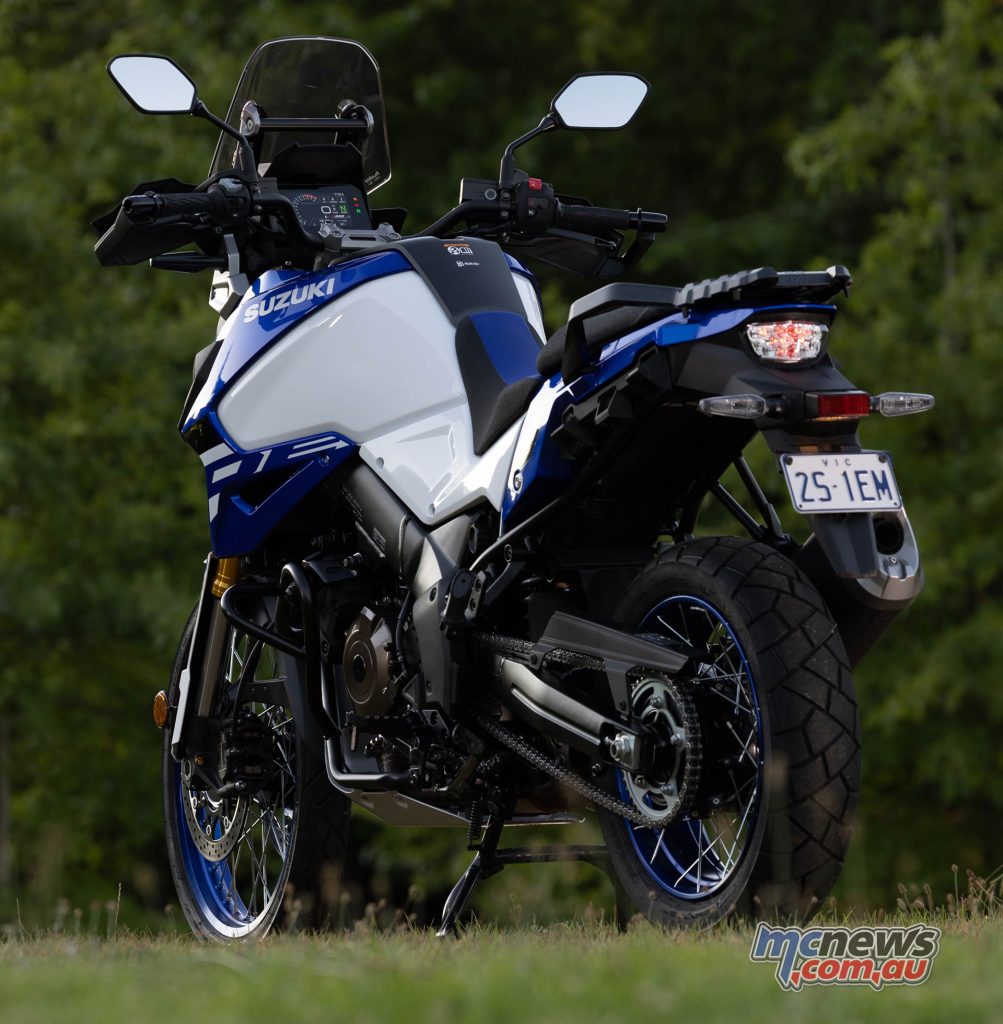Suzuki V-Strom 1050DE Review
V-Strom 1050DE review by Trevor Hedge – Images TBG
Suzuki’s V-Strom has a legendary reputation for comfort, reliability and amazing road performance. It has never had the off-road chops to compete in the dirt against many of its adventure bike competitors, nor has it pretended to.
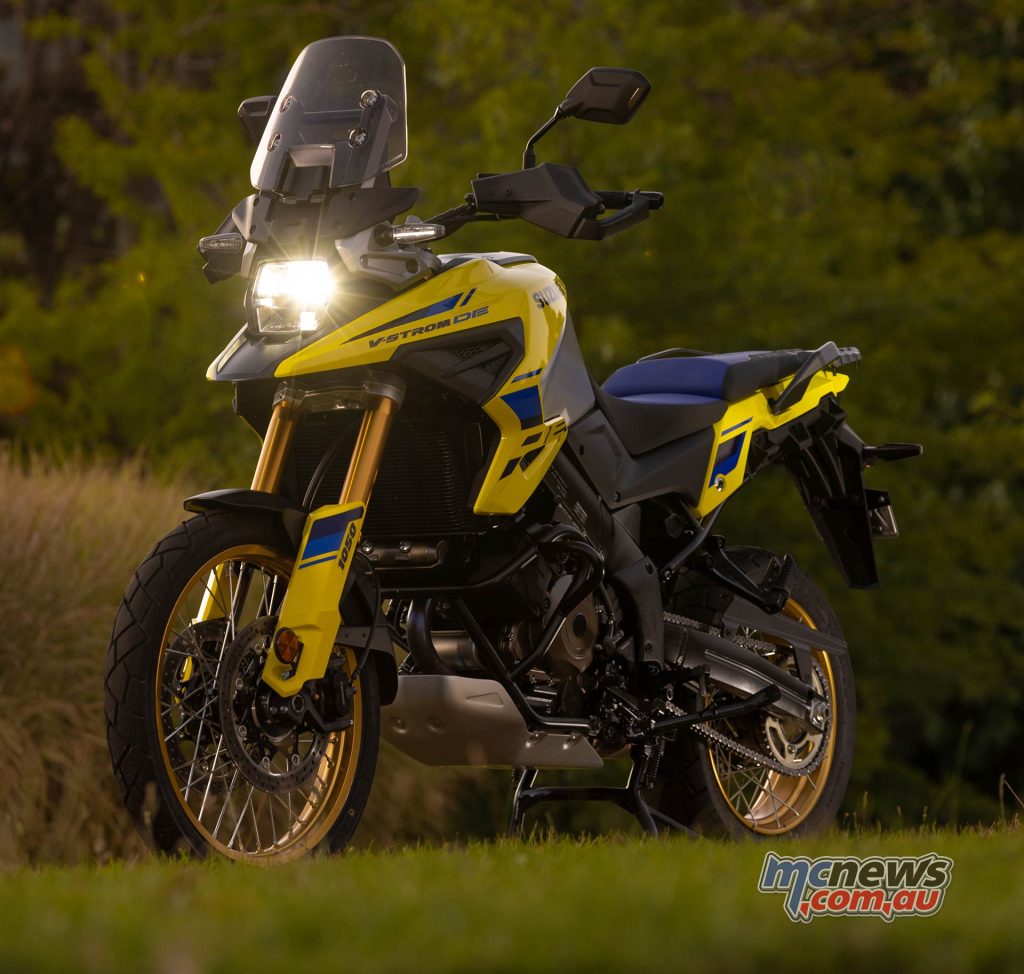
That’s not to say the harder stuff can’t be done on a V-Strom – it can, you just need to be a better rider to do it. Plenty of the V-Strom faithful have also transplanted front ends off big dirt-bikes onto their Stroms, fitted 21-inch fronts and done all manner of things to take their much-loved bikes towards the harder end of the adventure-touring spectrum.
Suzuki finally took the hint and gave us a little more dirt clout with the XT in 2020, and now really puts the gumboots on with the new DE (Dual Explorer) that went on sale recently. It might have taken them two decades to do it, but Suzuki has now produced a V-Strom with a 21-inch front for the first time and added more suspension travel straight from the showroom floor. The differentiation between the regular V-Strom and the DE version is much bigger than what we previously saw in the XT and the DE.
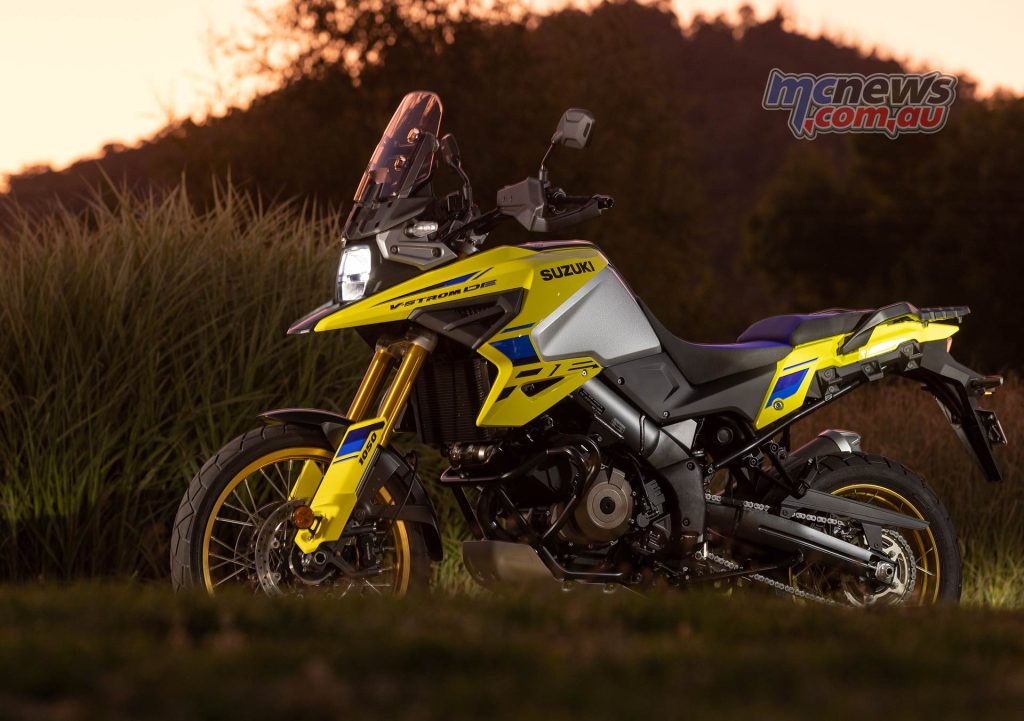
The more dirt oriented 1050DE model reviewed and pictured here sells for $24,690 ride away
The swing-arm is also longer on the DE and provides the model with a longer wheelbase. Up front there is also more rake to help the DE retain decent steering on the road, helping to counteract the negatives of a 21-inch front when it comes to cornering at lean on the tarmac.
These changes have certainly helped; the DE still steers very well but when cranked over on the bitumen it doesn’t feel quite as secure as its 19-inch fronted siblings, which to be fair have an awesome front-end well suited to pushing hard on tight and twisty blacktop. The front hoop on the new DE is a proper dirt 90/90-21 sizing, and that has a trade-off when terrorising the tarmac.
There’s some ‘nibbling’ when reaching the edge on the front, letting you know through the bars that’s about as far as you should go. The Dunlop Trailmax Mixtour rubber does a pretty good job of treading the line between tar and dirt performance, but physics are physics.
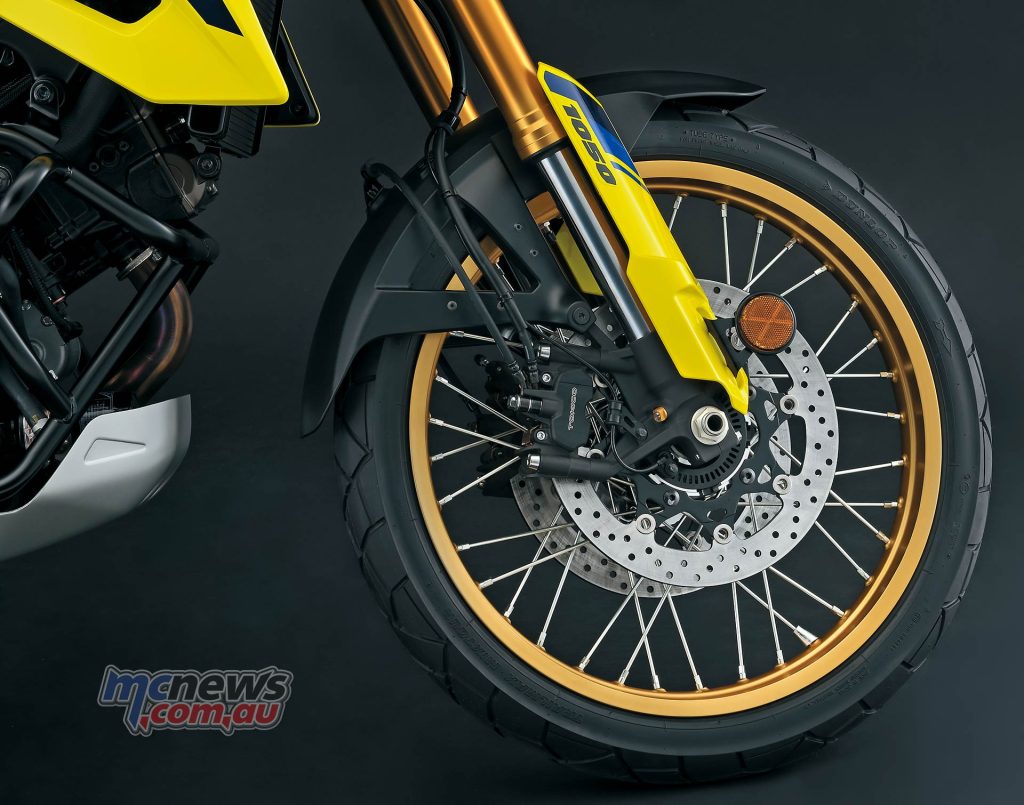
The V-Strom 1050DE boasts an inch more ground clearance than its more road oriented stablemate, which is also new for 2023 – 190 mm compared to the road-oriented 165 mm of its 19-inch stablemate.
Suspension travel is marginally greater with an extra 10 mm at each end of the KYB hardware. Not that 170 mm of travel is particularly generous; it’s a lot less than many comparable adventure bikes now on the market, and more than two-inches less than Suzuki’s own new 800DE.
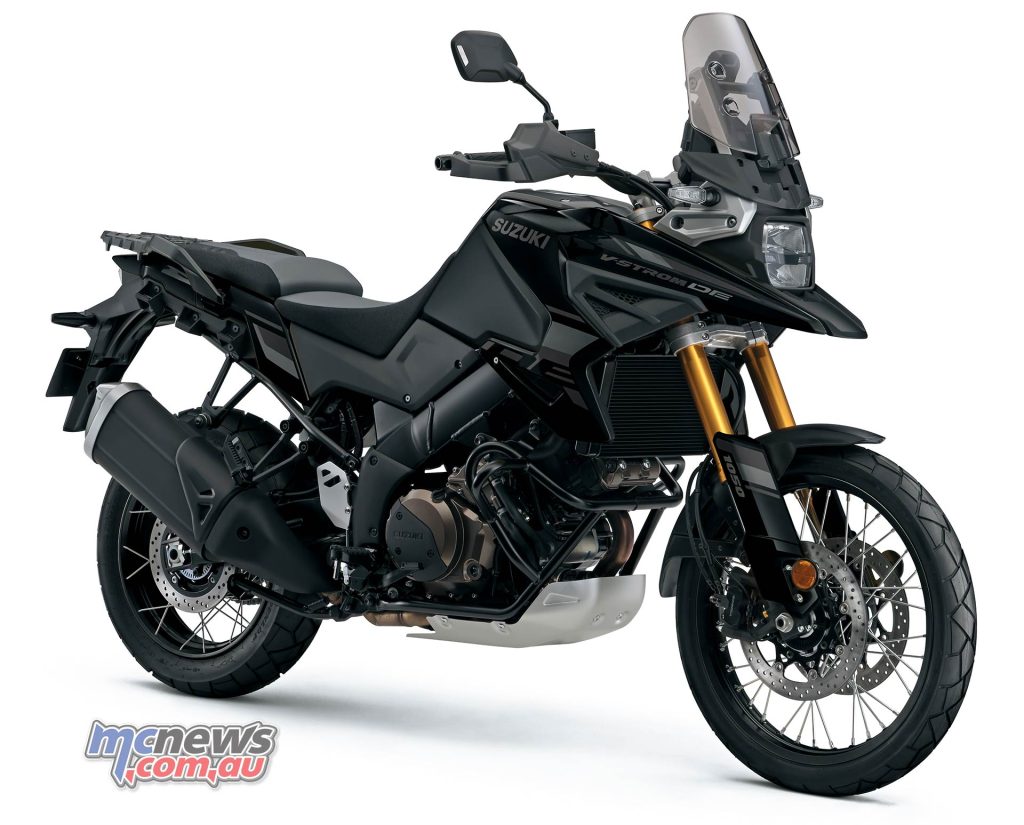
A decent bash-plate and crash bars are standard. The handlebars are 40 mm wider than the regular 1050 V-Strom and they do feel w-i-d-e. I would be experimenting with different positioning if taking a bike home for good.
If choosing the optional low seat there is less padding at the front which means it isn’t quite as friendly to the inside of your thighs as the regular perch. The low seat drops the seat height from 880 to 850 mm. For the fellas with real lanky legs you can also plump for an optional high seat that raises the seat height up to a heady 910 mm.
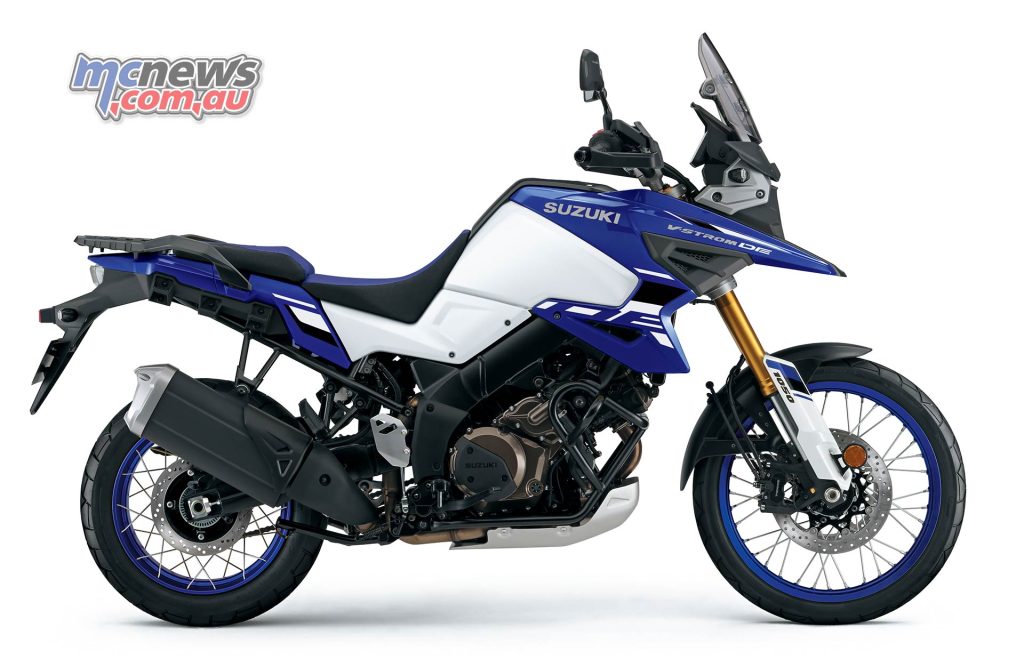
Suzuki started ramping up the electronic smarts with the XT but now really gets with the program on the DE. Updates have been made to the ride-by-wire electronic throttle along with an improved cruise control system, while a six-axis Bosch IMU now delivers much more data which facilitates vastly improved ABS and traction control systems. Hill hold control is also a feature on the DE.
The electronic improvements don’t set any new industry standards but they do help give the V-Strom a comparable suite of smarts to the competition and bring Suzuki back into the game in this area.
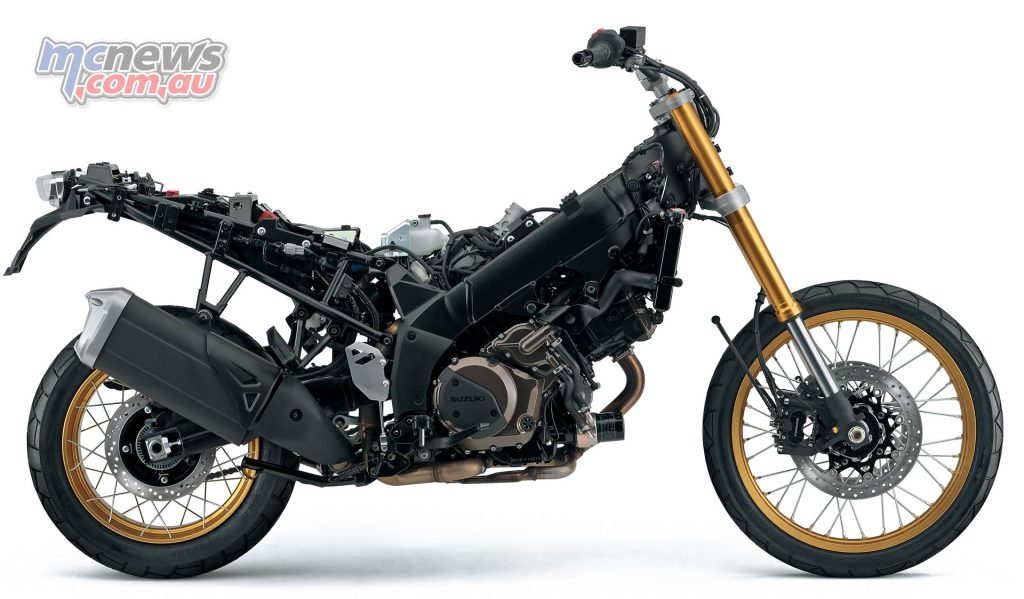
Curiously the rear wheel on the DE is tubeless, but the front is not. Tyre pressure monitoring is not available even as an option. Heated grips are optional and the switching for them is not pre-configured. The hand-guards provide some weather protection but I don’t think they would do all that much to prevent damage to your levers or master cylinders in a tumble.
The new TFT display is sharp and easy to read, and the interface is intuitive – I think perhaps best in class when it comes to HMI. Although, it does miss out on the smartphone-powered turn-by-turn navigation functionality that’s a feature on some of its higher-end competitors.
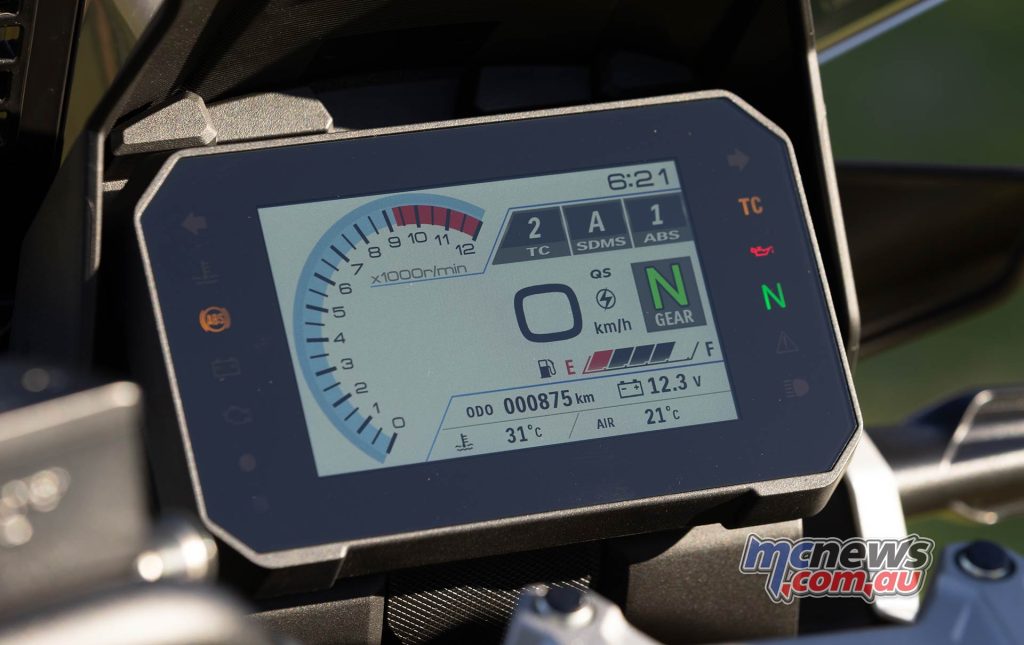
There are various riding modes on offer and the DE scores an extra G mode over its sibling. This mode allows much more liberal spinning and sliding of the rear before reining things in via traction control interventions.
I found A mode to be a little too direct, which made the ride quite tiring and a bit too urgent, so I preferred the more easy-going nature of B. The engine still feels plenty strong in this mode. Don’t let ‘only’ 106 horsepower on the spec sheet make you think the V-Strom is underpowered, as it isn’t. The Suzuki won’t lift the front wheel in third gear like some of the European monsters and charge past 240 km/h like a sportsbike of not too long ago, but it’s still more than powerful enough and rarely found wanting.
The rear ABS can be switched off but the front can’t. This isn’t as much of a hindrance as it once was as ABS systems work so much better and cycle far quicker than before.
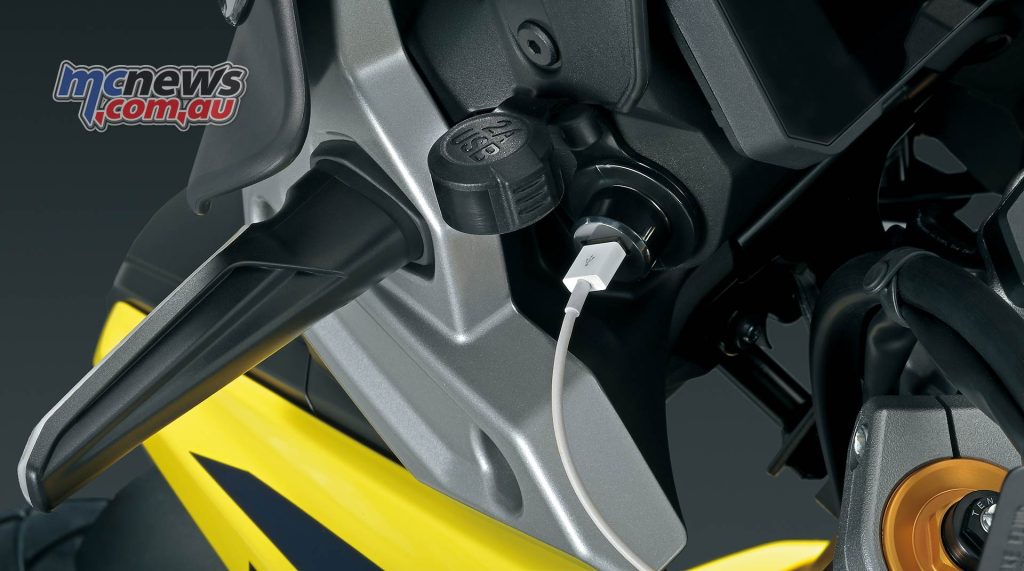
A USB port is provided up front and an old-school 12-volt socket can be found under the seat.
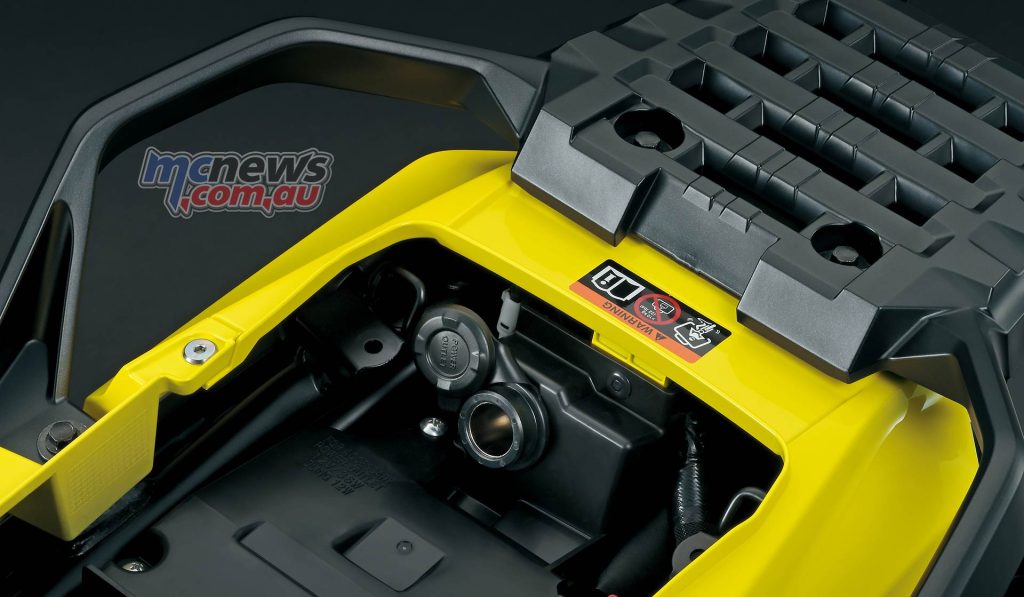
The two-way quick-shifter is very smooth and competent. However, if being fussy I would say the ignition cut was a little too long for my liking when wanting to play silly buggers on the road. No doubt this is Suzuki being its normal conservative Japanese self and taking no risk regarding gearbox longevity.
While the Europeans are content to push the envelope of engineering it often does come at the expense of reliability and customers sometimes get left to do the durability testing; the Japanese brands play the long game. And this is one of the reasons why the V-Strom has such a faithful following: they have always been, and likely always will be, bulletproof.
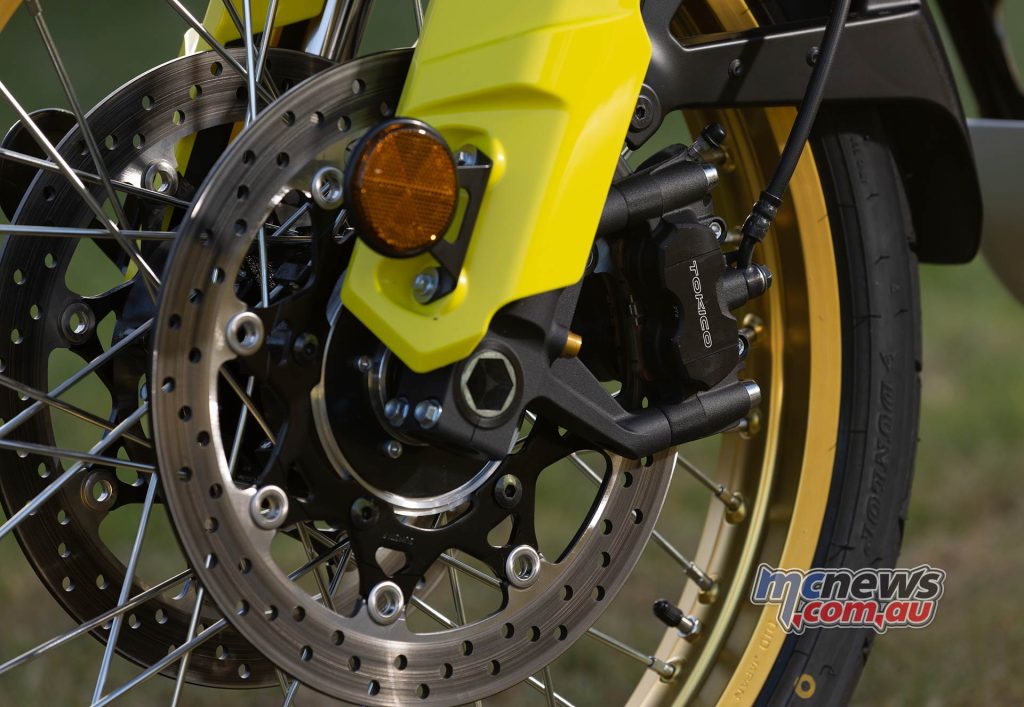
Tokico four-piston calipers up front offer ferocious stopping power. They must be applied carefully in the slippery stuff, but of course there is ABS for back-up. Maybe Suzuki would benefit from a top-shelf master cylinder for more progression, but there is certainly no shortage of braking power when you want it.
The standard 880 mm seat height is quite tall, and you do lose a bit of comfort if choosing the low seat. Combine that with a 252 kg wet (full 20-litre tank) weight and if you are a bit short of leg there might be a little sweating from time to time during low-speed work or while getting on or off the bike on uneven ground.
The weight is pretty much par for the course in this litre-plus adventure market, but the 1050DE does feel a little top heavier than most. Close-quarters manoeuvring isn’t helped by what feels like quite a limited steering lock which makes turning the bike around more onerous than it needs to be.

At 178 cm the 1050DE was a bit of a struggle height-wise, but I’m sure living with the bike day-in and day-out one would adapt and just get accustomed to it. Adventure motorcycle riding is a confidence game, and it takes regular seat time to build and retain that confidence.
Most other manufacturers have now gone away from making V-twins and are now instead investing their research and development budgets into producing parallel twins. This is largely due to parallel engines being so much more easily packaged in various types of motorcycles, and that weight being able to be positioned lower.
While there are some fantastic parallel twins now on the market, no amount of crankshaft off-set tinkering makes them a proper V-twin – which the Suzuki most certainly is, with the powerplant tracing its roots right back to the TL1000S a quarter of a century ago. Yes, it is that long ago and we are getting old….
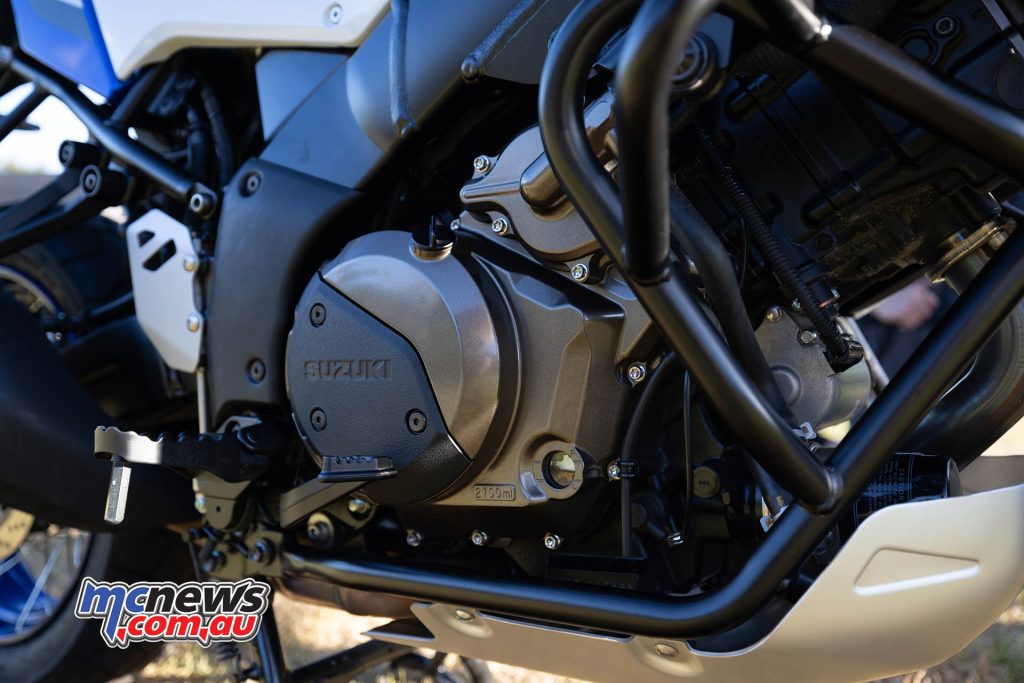
The 90-degree 1037 cc V-twin has been revised with new hollow sodium-filled valves and drives through an improved gearbox, with different internal ratios for first and sixth gears. There is no need for balance shafts in an engine that has perfect primary balance and this must be part of the reason why the response of the engine feels so instantaneous in comparison to most modern bikes.
A higher quality drive chain now turns a rear sprocket with four more teeth, but due to the internal ratio changes the final drive ratio difference is not as pronounced as that four teeth addition might suggest.
2023 V-Strom 1050 and 1050 DE gearing compared to predecessor
| Gearing | New model | Previous model |
| Primary | 1.838 (57/31) | 1.838 (57/31) |
| Final | 2.647 (45/17) | 2.411 (41/17) |
| 1st | 2.666 (32/12) | 3.000 (36/12) |
| 2nd | 1.933 (29/15) | 1.933 (29/15) |
| 3rd | 1.500 (27/18) | 1.500 (27/18) |
| 4th | 1.227 (27/22) | 1.227 (27/22) |
| 5th | 1.086 (25/23) | 1.086 (25/23) |
| 6th | 0.913 (21/23) | 1.000 (24/24) |
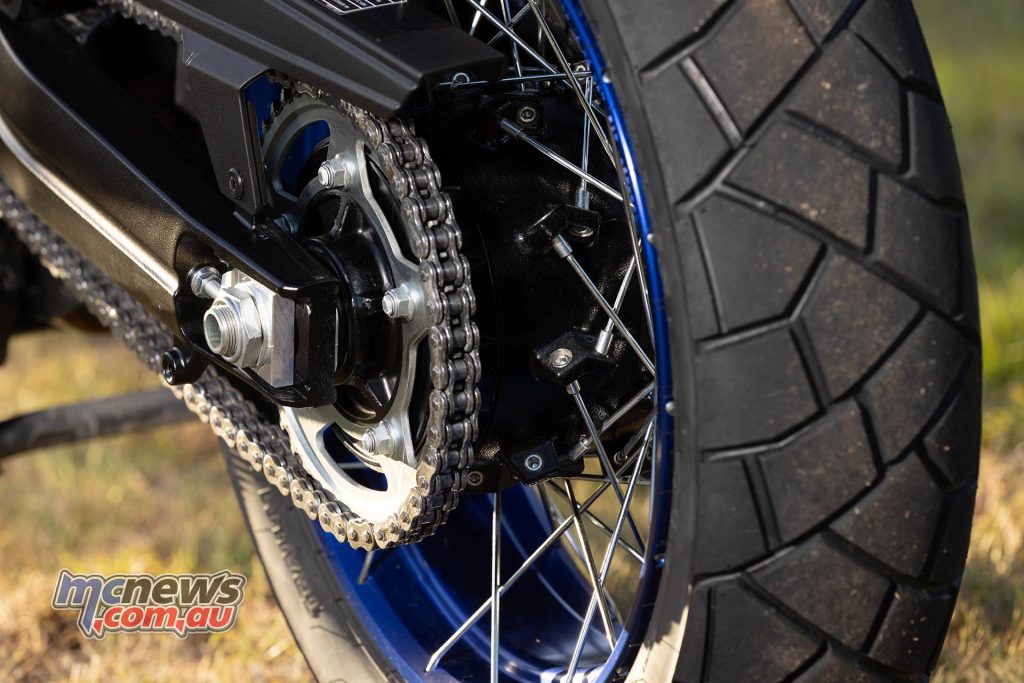
I did find the way the slip-assist clutch worked on deceleration a little disconcerting, it went through two stages – between which there was a surge which could be a little disconcerting on less than perfect surfaces.
Suzuki is now the only Japanese manufacturer still offering a V-twin engine, and perhaps this is why it has introduced the DE version of its big-bore despite the pending arrival of a parallel twin middle-weight 800DE around the middle of this year.
The new parallel-twin engined 800DE is, as you would expect, down on power compared to the 1050 (83 hp plays 106 hp), but it is 20 kg lighter while offering much more suspension travel and a lot more ground clearance – despite the seat height being an inch shorter. Surely those V-Strom buyers looking for the ultimate off-road variation on the model are going to choose the new 800?
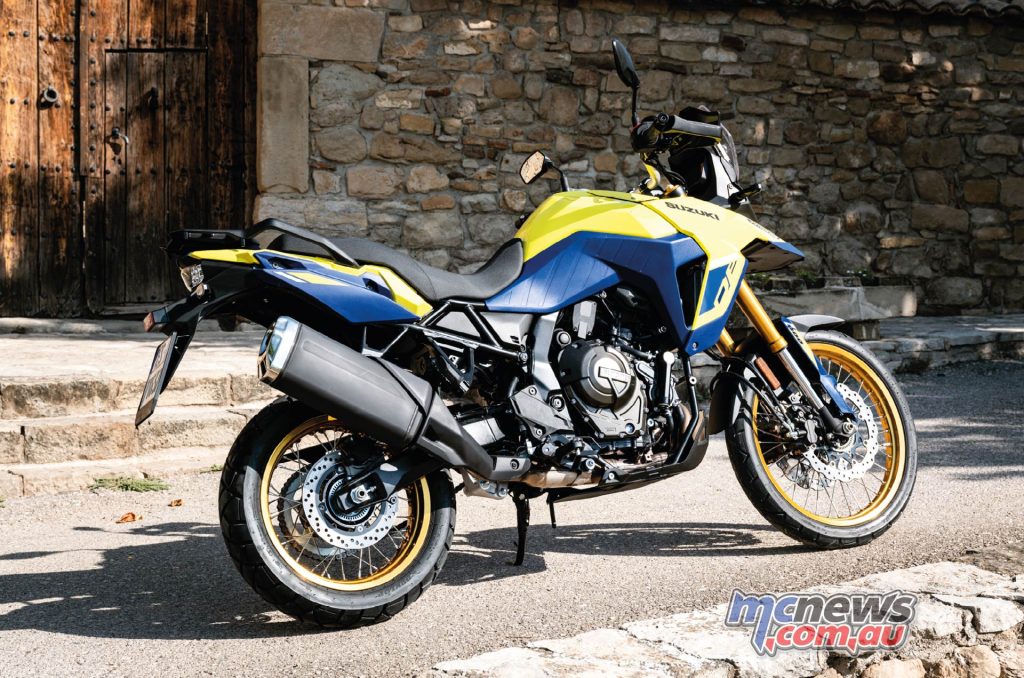
Thus, I did find the addition of this 1050DE quite a curious decision by Suzuki. Perhaps the 1050DE is introduced for those who want a bit better dirt performance from their 1050 V-Strom but also want the extra grunt that makes carrying a pillion and luggage a more pleasant affair?
As to my mind that would be the primary scenario where it really makes sense over the coming 800 model for those that want a dirt oriented V-Strom. However, after now also spending some quality time with the new 800DE, the differences between that and the 1050DE really are quite stark.
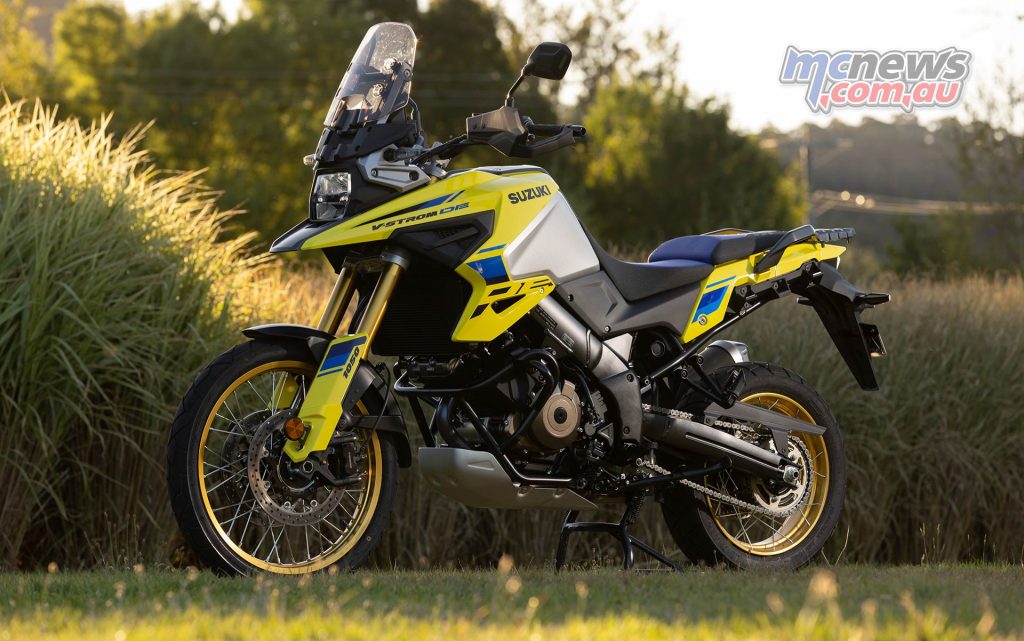
The 800 is so easy to ride on both the dirt and tarmac that it really is a whole different kettle of fish compared to the 1050DE. The 800 is so playful and an absolute doddle to ride in comparison to big brother. The 800 still has enough shove to also please experienced riders but it just feels a whole lot less, well, serious.
When pressing on, the 1050 is considerably faster, but demands a fair bit more from its rider in the process than the new 800. On paper the power and torque differences are only around 25 per cent, but the 1050 feels punchier and more serious in comparison to the playful, easy-going nature of the 800. The instant response of the V-Twin makes it feel like its packing way more than its quoted 100 Nm of torque, way more. I think Japanese horses must have bigger feet than European ones…
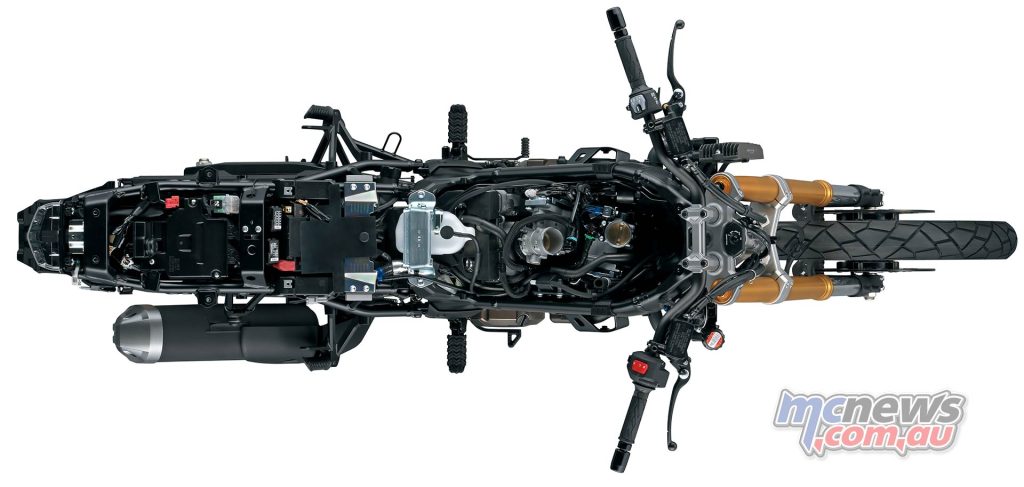
The 800’s lightness also certainly helps, but I feel that mass only plays a bit part in the equation. The suspension is much softer on the 800 and its Nissin brakes have much less initial bite than big brother’s Tokicos, helping to instill a calmer demeanour on the 800.
Both 1050 models have mounts for luggage integrated into the rear sub-frame, while on the 800 the mounting kit is an optional extra.
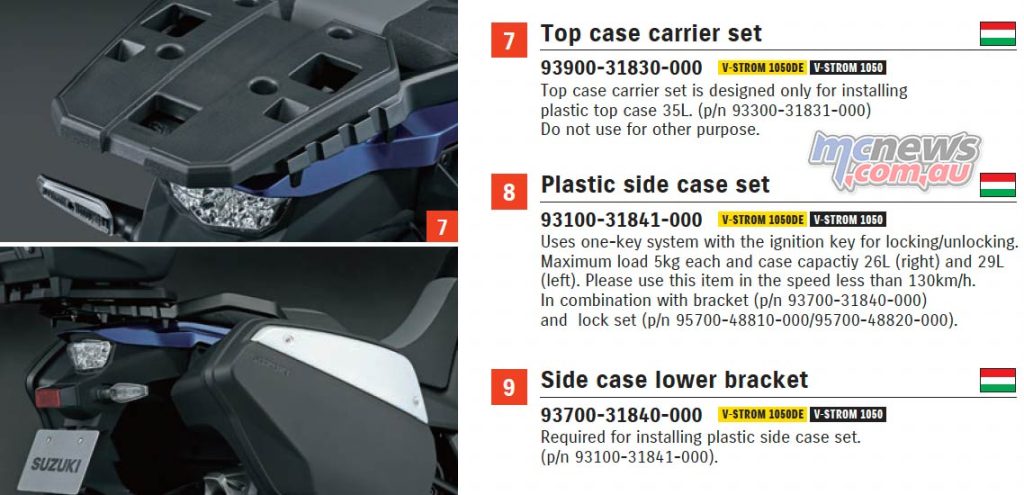
Funnily enough, Suzuki makes no real boast about the integrated luggage mounting system. I had to do some digging to glean any information on the plastic panniers, as there is no mention of it in the press kit or model information. Maybe Suzuki just think that everyone wants a heap of metal work on the side of their bikes along with huge and ungainly aluminium panniers when it comes to luggage.
Alloy panniers do have their place for two-up road touring but generally ruin a bike’s dynamics. The weight and bulk pushed out so far from the centre line of the bike is far from ideal – and this goes for all bikes equipped with this type of kit and not just Suzuki. Not to mention how many broken ankles and lower legs alloy panniers have been responsible for in small off-road tip-overs.
Both the plastic and alloy panniers are only manufacturer rated for 130 km/h, again, that is the Japanese and their legal eagles being overly cautious. The plastic cases hold 29 litres on the left and 26 litres on the right (due to having to accommodate the exhaust). The metal side cases hold 37 litres either side but are only rated to hold 3 kg each, while the smaller but more tightly integrated plastic luggage is rated at 5 kg each side. This has to be down to those dynamics I mention, and not due to strength.
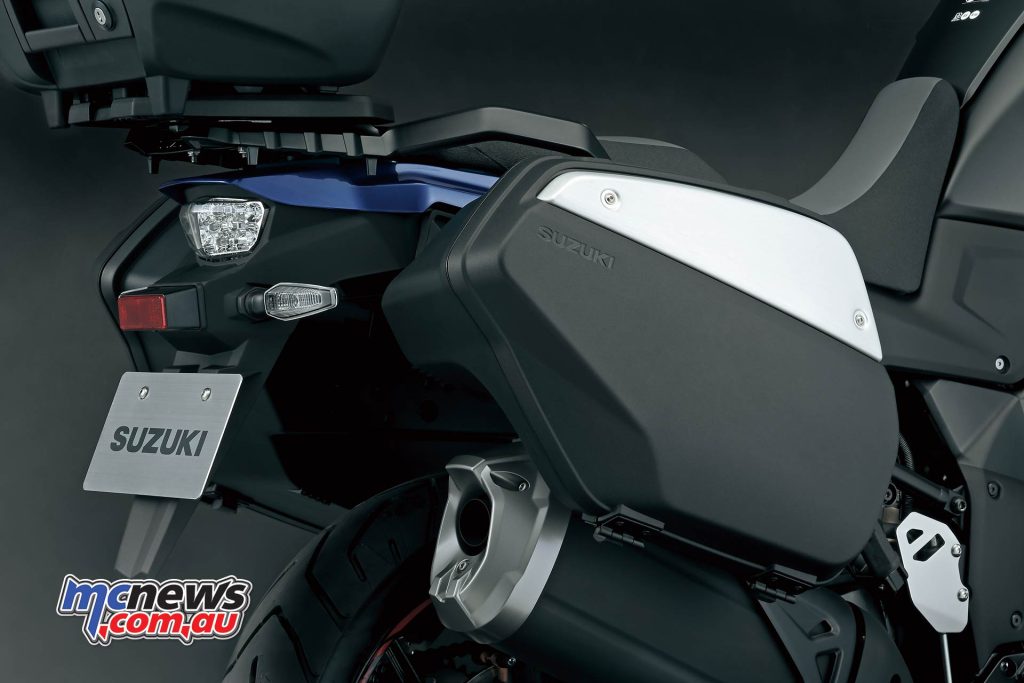
I would certainly be investigating the plastic factory luggage that mounts directly to the sub-frame, as I am 100 per cent sure the difference between those and a couple of huge ugly boxes hanging out in the breeze would be chalk and cheese when it comes to riding pleasure. That has certainly been my experience where other manufacturers offer an integrated sub-frame mounting system.
They hold a little less but you can always put a big roll bag on the rear luggage grid, which could also serve as a nice back rest for a pillion. Speaking of passengers, the Strom has absolutely huge grab handles and should accommodate two-up riding quite well.
On offer also are optional tank-bags that mount on a ring fixed to the fuel cap surround.
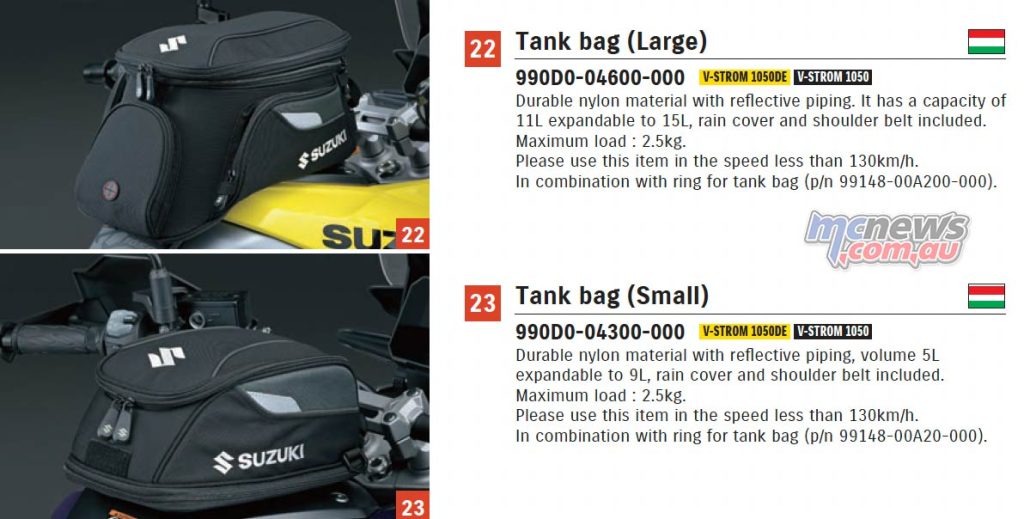
Thankfully, most of the non-dirt-oriented improvements that feature on the $24,690 (ride away) 1050DE are also now introduced on the regular 2023 V-Strom 1050 and will help to make it a better road bike than ever. You miss out on that spoked 21-inch front, have 10 mm less suspension travel and ground clearance, but you do have a much lower seat height (as low as 820 mm with optional low seat), rims better sized for road work and a much larger adjustable windscreen. The normal 1050 is also 10 kg lighter than the DE and costs $1700 less.
To my mind the standard model sounds like the sweet spot in the range for a lot of riders who don’t really need a 21-inch front and those minor improvements on suspension travel, but instead put more value on outright street performance, and a lower seat height.
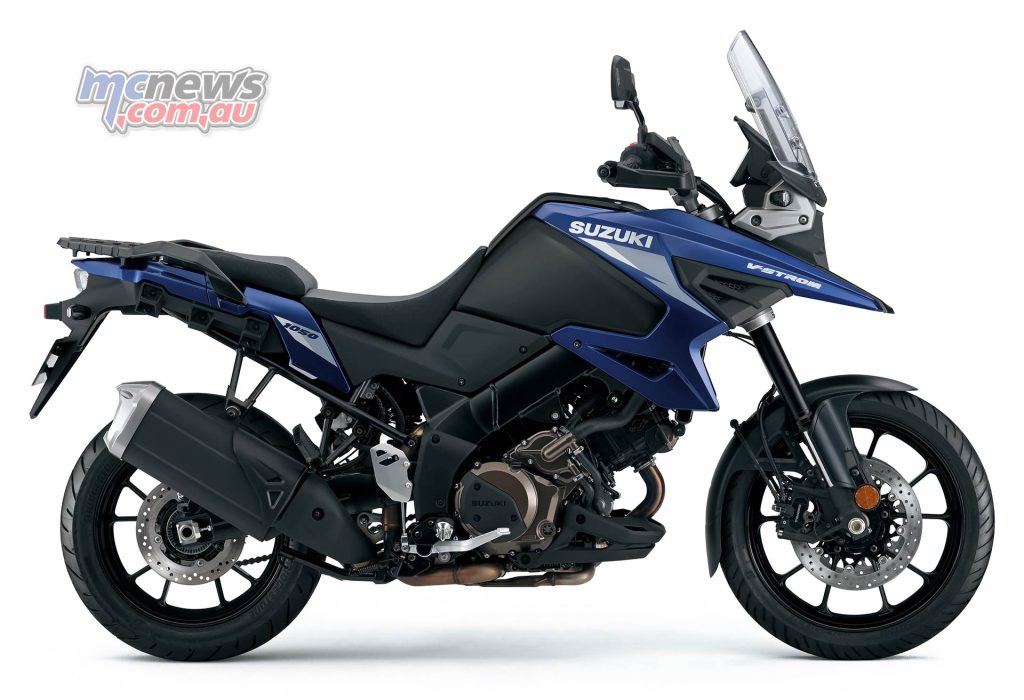
For those who do value that off-road part of the equation though there is indeed a lot of added value in all the kit that is included in the DE for that modest $1700 increase. And then of course there is also the new 800DE. Decisions, decisions…
2023 Suzuki V-Strom 1050 and 1050DE Specifications
| V -STROM 1050 | V-STROM 1050DE | |
| Engine | Liquid-cooled, V-twin 1,037 cc | Liquid-cooled, V-twin 1,037 cc |
| Bore x Stroke | 100 x 66 mm | 100 x 66 mm |
| Power | 106 hp / 79 kW at 8500 rpm | 106 hp / 79 kW at 8500 rpm |
| Torque | 100 Nm at 6000 rpm | 100 Nm at 6000 rpm |
| Compression ratio | 11.5:1 | 11.5:1 |
| Fuel system | Fuel injection, 49 mm throttle bodies, large bore, RbW | Fuel injection, 49 mm throttle bodies, large bore, RbW |
| Starter system | Electric | Electric |
| Lubrication system | Wet sump | Wet sump |
| Transmission | 6-speed constant mesh | 6-speed constant mesh |
| Ignition system | Electronic ignition (transistorized) | Electronic ignition (transistorized) |
| Fork | 43mm KYB inverted front forks, full adjustable, 160 mm travel | 43mm KYB inverted front forks, full adjustable, 170 mm travel |
| Shock | Link-type KYB mono-shock, full adjustable, 160 mm travel | Link-type KYB mono-shock, full adjustable, 169 mm travel |
| Rake / trail | 25°40’ / 110 mm | 27° 30’/ 126 mm |
| Frame | Twin-spar aluminium frame, Aluminium swingarm | Twin-spar aluminium frame, longer, aluminium swingarm |
| Brake Front | CBS, Tokico radial mount monobloc four-piston caliper, 310 mm rotors, ABS | CBS, Tokico radial mount monobloc four-piston caliper, 310 mm rotors, ABS /w rear cancel mode |
| Brake Rear | Single-piston pin-slide calliper, 260 mm rotor | Single-piston pin-slide calliper, 260 mm rotor |
| Wheels | 10-spoke cast aluminium wheels | Wire-spoked wheels, aluminium front rim |
| Tyre Front | Bridgestone Battlax Adventure A41, 110/80R19M/C 59V tubeless | Dunlop TRAILMAX MIXTOUR, 90/90-21M/C 54H tube type |
| Tyre Rear | Bridgestone Battlax Adventure A41, 150/70R17M/C 69V tubeless | Dunlop TRAILMAX MIXTOUR, 150/70R17M/C 69H tubeless |
| Fuel capacity | 20.0 L | 20.0 L |
| Handlebars | Tapered aluminium | Tapered aluminium, 20 mm wider per side |
| Footpegs | Aluminium, rubber-covered | Steel, rubber covered |
| Rake / Trail | 25°40′ / 110 mm | 27°30′ / 126 mm |
| Overall length | 2,265 mm | 2,390 mm |
| Overall width | 940 mm | 960 mm |
| Overall height | 1515 mm | 1,505 mm |
| Wheelbase | 1555 mm | 1,595 mm |
| Ground clearance | 165 mm | 190 mm |
| Seat height | 855 mm | 880 mm |
| Kerb mass | 242 kg with full tank | 252 kg with full tank |
| RRP | $22,990 Ride Away | $24,690 Ride Away |
